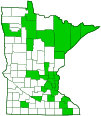common eupithecia
(Eupithecia miserulata)
Conservation • Description • Habitat • Ecology • Distribution • Taxonomy
|
||||||||
| Hodges # | 7474 |
|||||||
Conservation Status |
||||||||
| IUCN Red List | not listed |
|||||||
| NatureServe | NNR - Unranked |
|||||||
| Minnesota | not listed |
|||||||
Description |
||
With more than 1,400 species worldwide, Eupithecia is by far the largest genus of moths in the world. There are more than 140 species found in North America north of Mexico. At least 14 species are found in Minnesota. Eupithecia are small to very small moths with muted colors and indistinct markings that make them difficult to identify. Some are look-alikes and cannot be identified by simple visual examination. Many museum collections have specimens that have been unreliably identified. Common eupithecia is a common, small to very small pug moth. It occurs in the United States east of the Great Plains and on the West Coast, in adjacent Canadian provinces, and in Mexico. It is one of the most common species, or at least one of the most commonly reported species, in the eastern United States. It is common in Minnesota. Adults are small, with a wingspan of just ½″ to ¾″ (12 to 20 mm). The face is flat, sloping, and light cream-colored. The sense organs attached to the mouth (palpi) are long, blade-like, and dark smoky brown. They extend forward far beyond the front of the face. On the male, the antennae have numerous bundles of long plume-like hairs (cilia) on a raised, peg-like base (fascicle). Each antenna segment has three pairs of fascicles and a single bristle at the base. The female antennae lack the fascicles but are evenly and finely ciliate and also have a bristle at the base. The forewing is pale grayish-brown with dark markings. There is a large, conspicuous, black spot in the middle of the wing (discal spot), and a subterminal line consisting of a row of white spots. The innermost spot, near the inner (anal) angle of the wing, is larger and more prominent. The hindwing is similarly colored but with a smaller discal spot and a less prominent subterminal line. The caterpillar is small, about ⅝″ long. The color is variable and often blends with the plant on which it feeds. The first six or seven abdominal segments have a broad, oblique, subdorsal line on each side that often joins with the line on the opposite side to form a downward-pointing arrow. There is often a weak narrow line in the middle (middorsal line) and a weak narrow line on each side (subdorsal lines). There is always a narrow white line below the breathing pores (spiracles) on each side (subspiracular lines). The surface of the body is rough due to seven to nine relatively deep creases on each abdominal segment. Mature caterpillars are present from May until the first frost in the fall. |
||
Size |
||
Wingspan: ½″ to ¾″ (12 to 20 mm) |
||
Similar Species |
||
Habitat |
||
Woodlands, fields, gardens |
||
Ecology |
||
Season |
||
At least two generations per year in Minnesota: April to late October |
||
Behavior |
||
Adults are active at night and will come to lights. The wings are held flat when at rest. |
||
Life Cycle |
||
Pupa overwinter |
||
Larva Hosts |
||
Many woody and herbaceous plants, including grape, juniper, oak, viburnum, willow, dock, St. John’s wort, aster, black-eyed Susan, clover, fleabane, goldenrod, joe-pye weed, sunflower, and yarrow. |
||
Adult Food |
||
|
||
Distribution |
||||
|
Sources |
|||
| 8/30/2022 | ||||
Occurrence |
||||
Widespread and common |
||||
Taxonomy |
|||
Order |
Lepidoptera (Butterflies and Moths) | ||
Superfamily |
Geometroidea (Geometrid and Swallowtail Moths) | ||
Family |
Geometridae (Geometer Moths) | ||
Subfamily |
Larentiinae (carpet moths) | ||
Tribe |
Eupitheciini (pug moths and allies) | ||
Genus |
Eupithecia (pug moths) | ||
Synonyms |
|||
Eupithecia grossbeckiata Eupithecia nebulosa Eupithecia plumbaria Tephroclystia nebulosa Tephroclystia plumbaria |
|||
Common Names |
|||
common eupithecia common eupithecia moth common pug |
|||
Glossary
Palp
Short for pedipalp. A segmented, finger-like process of an arthropod; one is attached to each maxilla and two are attached to the labium. They function as sense organs in spiders and insects, and as weapons in scorpions. Plural: palpi or palps.
Spiracle
A small opening on the surface of an insect or arachnid through which it breathes.
Visitor Photos |
|||||
Share your photo of this insect. |
|||||
| This button not working for you? Simply email us at info@MinnesotaSeasons.com. Attach one or more photos and, if you like, a caption. |
|||||
Babette Kis |
|||||
Eupithecia miserulata common eupithecia Eupithecia miserulata, common eupithecia, caterpillar on Queen of the Prairie flowers, July 13, 2020. Photos taken at Barnes Prairie, Racine Co., WI. |
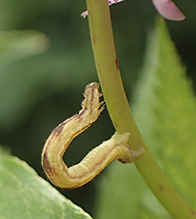 |
||||
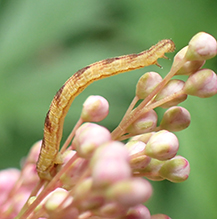 |
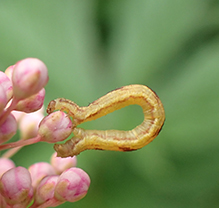 |
||||
Emily Benjamin |
|||||
on a gladiola flower |
|||||
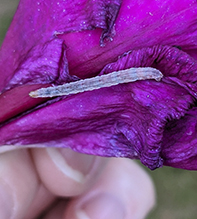 |
|||||
Alfredo Colon |
|||||
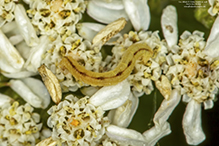 |
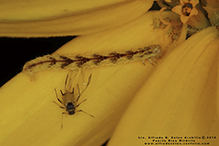 |
||||
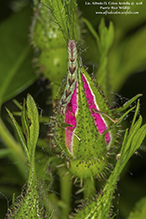 |
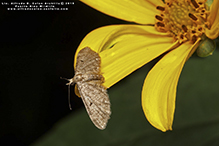 |
||||
MinnesotaSeasons.com Photos |
|||||
|
|||||

Visitor Videos |
|||
Share your video of this insect. |
|||
| This button not working for you? Simply email us at info@MinnesotaSeasons.com. Attach a video, a YouTube link, or a cloud storage link. |
|||
Other Videos |
|||
| Common Eupithecia Moth (Geometridae: Eupithecia miserulata) on Window Pane Carl Barrentine |
|||
About
May 8, 2011 Photographed at Grand Forks, North Dakota (08 May 2011). |
|||
| Common Pug Moth Caterpillar (Geometridae: Eupithecia miserulata?) Carl Barrentine |
|||
About
Sep 17, 2011 Photographed at the Turtle River State Park, North Dakota (17 September 2011). |
|||
| Eupithecia miserulata [Common Eupithecia] Feeding on Centaurea cyanus [Cornflower] Zenthanol |
|||
About
Sep 2, 2014 🐝 Subscribe for weekly #Zenthanol videos: https://www.youtube.com/user/Zenthanol Social Media: June 27, 1917, 2013 For a good long while, I wasn't sure about the nature of these caterpillars that I'd found both in my Cornflowers and (more recently) my Peppermint florets--I noticed they seemed to enjoy staying in the flowers themselves, but didn't do damage to the actual petals. I thought they must be pollen or nectar-feeders. They kept themselves still as if to mimic a twig or stick, and at night they would not react to light, and barely react to physical stimuli (at least on the Peppermint florets). The adults of this species are a group of moths (mainly Genus Eupithecia) known as "Pug Moths", which are actually pretty prevalent here in San Diego I think--drab colors, and 90° folded wings, somewhat nondescript they can hide amongst stucco and other man made features pretty easily. |
|||
| Common Eupthecia Moth (Geometridae: Eupithecia miserulata) Dorsal view Carl Barrentine |
|||
About
Oct 13, 2011 Photographed at Grand Forks, North Dakota (09 October 2011). Thank you to Maury Heiman (@Bugguide.net) for confirming the identity of this specimen! |
|||


Created: 10/10/2019
Last Updated:
